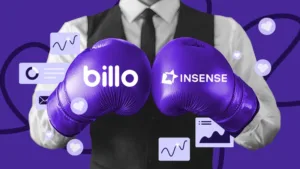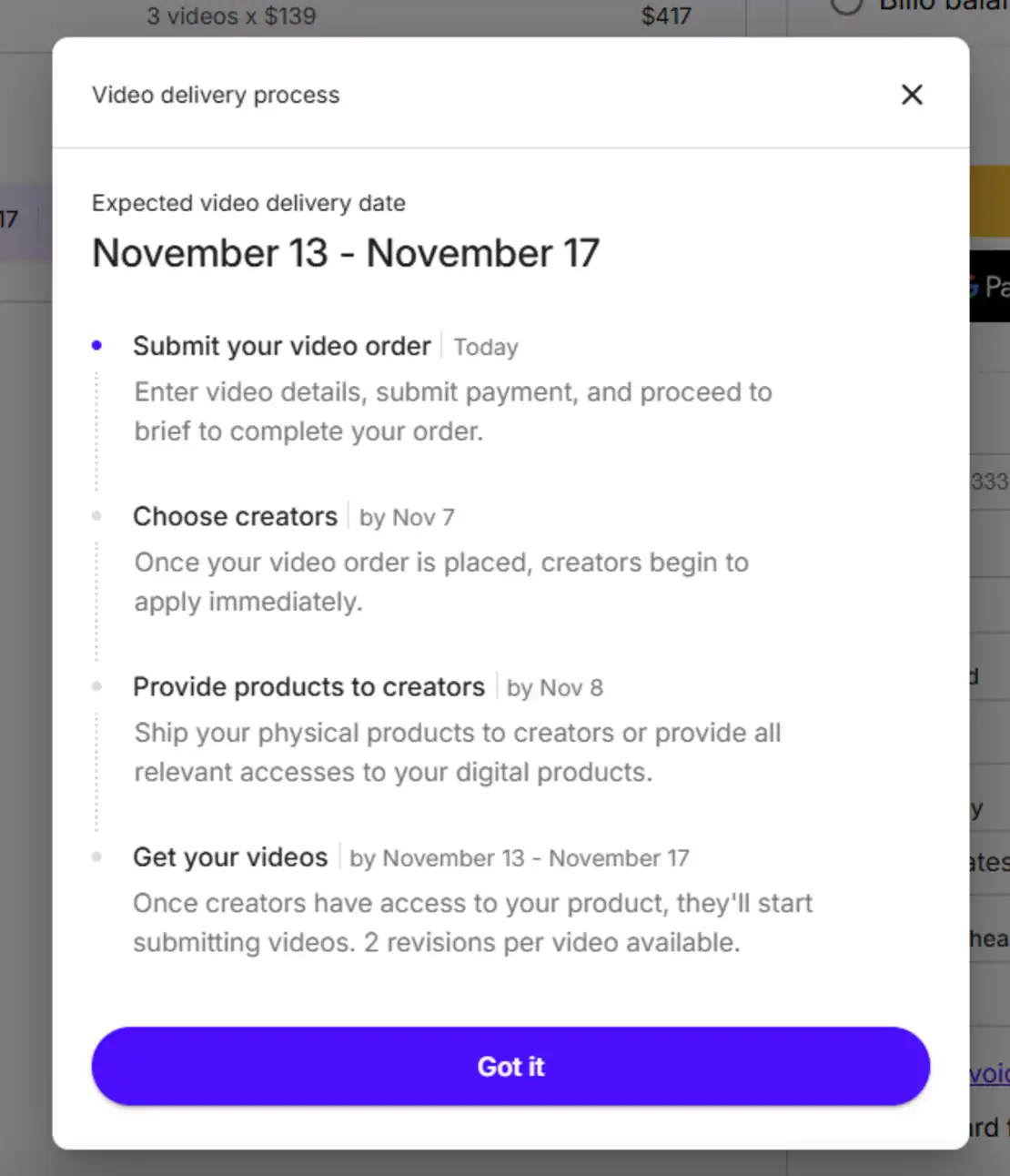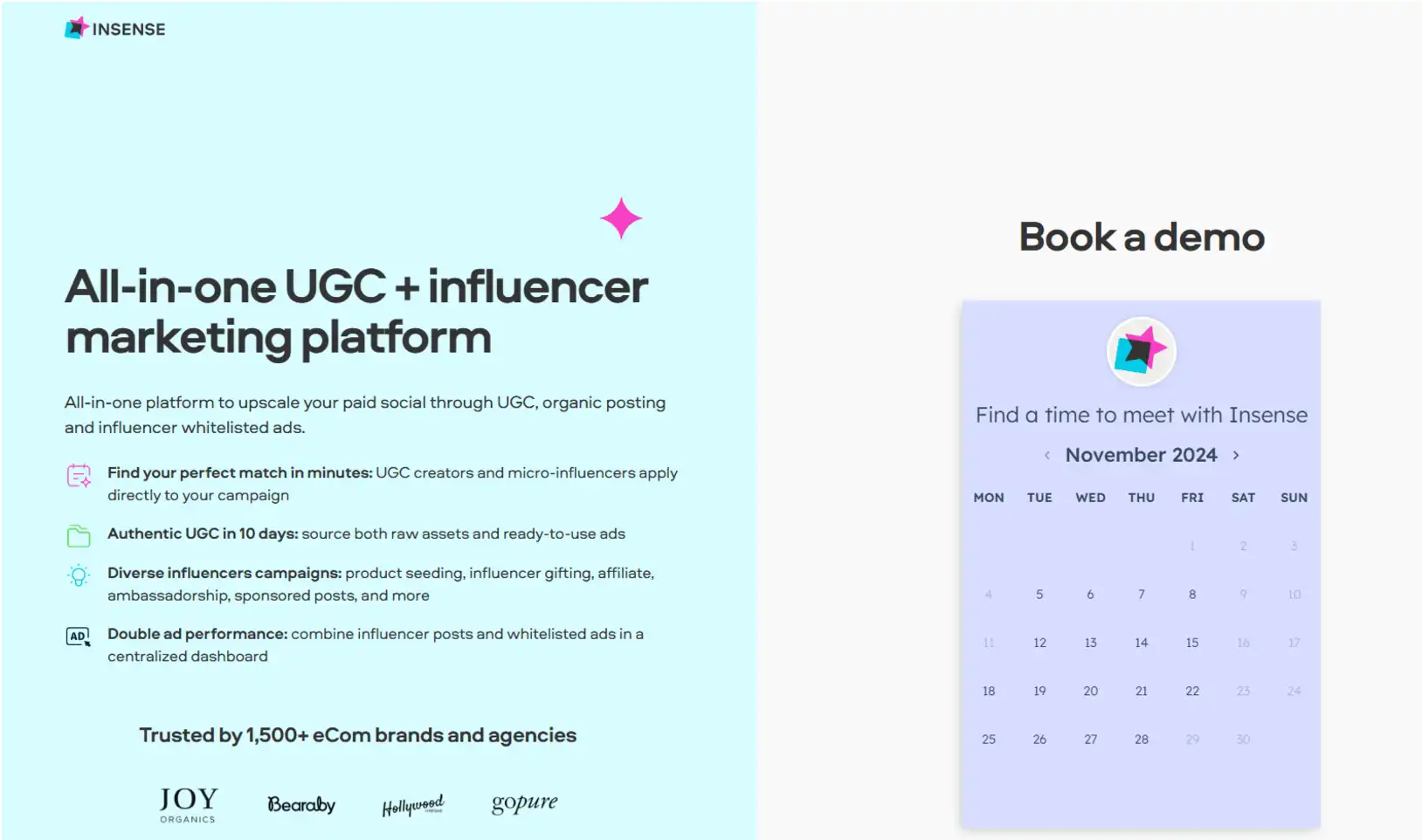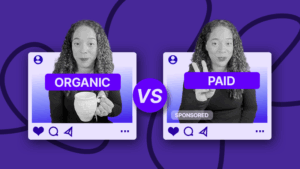Billo vs Insense: A Detailed Guide For Choosing The Right UGC Platform For Your Brand
With over 7 years of e-commerce experience, Agne has mastered the balance of creativity and performance. From guiding social media strategies to crafting high-converting ads, she’s all about results.

Billo and Insense are both popular platforms in the creator marketing space, but they’re built for very different purposes. While Insense operates as a UGC marketplace for sourcing creator content, Billo is the first full Creator Marketing Stack, designed to turn UGC into a predictable growth channel.
Getting down to the basics, Billo goes beyond simply delivering videos. Its CreativeOps™ engine uses AI and live performance data from 150,000+ ads and $280M in tracked purchase value to generate smart briefs, match you with proven creators, and deliver ad-ready content that’s optimized to scale on TikTok, Meta, YouTube, and beyond. Every campaign runs through a closed-loop workflow: brief → match → produce → launch → measure → iterate, so results compound over time.
Insense, by contrast, provides a more traditional service: it connects brands with influencers and creators to produce UGC content for campaigns, including influencer-run ads on TikTok, Facebook, and Instagram. While this can be useful for brands looking for quick access to influencer-style UGC, it lacks the performance-focused system that sets Billo apart.
So which platform is right for your brand? That’s what this guide explores. We’ll break down the differences in features, pricing, workflow, and performance so you can decide whether you need a UGC marketplace like Insense or a growth engine like Billo.
Billo Vs Insense: Core Featured Compared
Billo and Insense both offer brands access to creator-driven content, but their approaches are fundamentally different. Billo is a Creator Marketing Stack built for performance, while Insense functions more as an influencer-focused UGC marketplace.
Here’s a breakdown of how they compare:
Core features: Billo vs Insense
| Billo | Insense | |
|---|---|---|
| Content type | Performance-driven creator ads (organic posting, partnership ads, creator content) designed to scale | Mixed UGC formats, including influencer posts, stories, and whitelisted ads |
| Ideal customer | DTC brands, startups, and agencies needing data-backed, scalable ad content | Brands seeking a wide variety of UGC formats with influencer-led campaigns |
| Data analysis | CreativeOps™ dashboards: ROAS, CTR, Hook Rate benchmarks from 150,000+ ads, $280M in purchase value | Demographic insights, reach, and ROI tracking tied to influencer campaigns |
| Campaign management | Closed-loop workflow: brief → creator match → produce → launch → measure → iterate | Campaign setup + influencer collaboration with multi-format approvals |
| Customization options | AI-generated briefs, data-powered creator matching, instant ad variations | Flexible orders with audience filters and creator-selected content styles |
| Platform integrations | Syncs with Meta Ad Accounts for live performance data, plus e-commerce integrations | Integrates with social media platforms for influencer campaign management |
| User-friendliness | Beginner-friendly, campaigns launch in hours; streamlined process for scale | Rich in features but more complex; suited to enterprise teams and advanced marketers |
| Creator network size | 5,000+ performance-vetted creators proven to deliver conversions | Larger influencer pool, focused on Gen Z and branded influencer campaigns |
| Pricing | Simple, transparent: from $99 per video | More complex: subscriptions, licensing fees, and marketplace commissions |
Overall, Billo is transparent, performance-driven, and fast to set up. Campaigns can launch within hours, and every creative decision is guided by live performance data – helping brands cut guesswork and scale what works.
By contrast, Insense caters more to enterprise teams seeking influencer-led campaigns with multiple content types. While it provides more format flexibility, it often comes with added complexity, heavier pricing, and less emphasis on direct ad performance.
Pricing Breakdown: Which Platform Fits Your Budget?
Billo and Insense take very different approaches to pricing. Billo is simple, transparent, and performance-focused, while Insense leans toward a more complex, subscription-based model.
Billo Pricing
Billo’s pricing starts at $99 per video, with bulk order bonuses available for brands looking to scale quickly. Custom packs are also available for larger campaigns.
What makes Billo different is its straightforward, risk-free structure:
- One clear upfront fee, no hidden charges
- Full refund if a creator match isn’t found
- No ongoing subscriptions or seat licenses
- The flexibility to scale campaigns up or down as needed
This makes Billo ideal for brands that want ad-ready content without long-term commitments, and ensures every dollar goes directly into producing creative that drives performance.
Insense Pricing
Insense uses a subscription model with three tiers: Trial, Brand, and Agency.
- Trial: A one-month test allowing one campaign and up to ten creators.
- Brand: A quarterly or annual plan designed for ongoing campaigns with influencers and creators.
- Agency: An enterprise-level tier offering unlimited licenses, campaigns, and whitelisted ads.
However, Insense pricing can add up quickly. Beyond the base subscription, clients are charged for user seats, brand slots, and licenses, plus a marketplace fee of 20% on Trial and 10% on Brand subscriptions, added to each creator payment.
Bottom line: Billo gives brands a simple, transparent way to scale creator ads without hidden costs or subscription overhead. Insense, while offering more enterprise controls, requires heavier commitments and ongoing fees that can make campaigns more expensive and less flexible.
User Experience And Interface: Navigating Billo vs Insense
Billo is built for simplicity and performance. It’s designed for brands, ecommerce stores, and agencies that want ad-ready creator content without the chaos of influencer management.
Onboarding is fast and intuitive. Instead of juggling endless back-and-forth communication, Billo’s CreativeOps™ workflow guides you step by step: generate a data-backed brief, match with vetted creators, manage revisions, and track performance – all in one place. Campaigns can be launched in minutes, not weeks. More on creative coaching with AI.

Brands can specify platform goals (TikTok, Meta, YouTube, Amazon, and more), creative formats, and ad specs like length or aspect ratio. From there, Billo surfaces creators who are not only a stylistic fit but have proven track records of performance. The process ensures that every piece of content is optimized for conversions before a dollar is spent on ads.
Communication is built into the workflow. Instead of chasing DMs, brands and creators collaborate directly inside the platform: briefing, feedback, revisions, and approvals happen on a single timeline. Over time, this enables brands to build long-term partnerships with high-performing creators, compounding results campaign after campaign.

Insense, by contrast, has a steeper learning curve. Its onboarding process is more complex, with a heavy focus on enterprise campaign setup. While it provides demos and walkthroughs, the interface is packed with filters, targeting tools, and influencer management features, making it powerful, but harder to navigate for smaller teams.
Communication in Insense follows a more structured submission-and-approval process. This works well for enterprises that want rigid workflows, but it can feel less personal and makes it harder to develop authentic, long-term creator relationships.

Finally, the platforms diverge in analytics. Billo’s performance dashboards surface key metrics like ROAS, CTR, and Hook Rate, helping brands double down on what works. Insense leans more into audience insights and demographic breakdowns – useful for influencer sponsorships, but less actionable for scaling direct-response ads.
Billo’s Unique Benefits For Specific Business Niches
Billo offers unique benefits for specific business niches, focusing on those most likely to want to use UGC.
Ecommerce Brands
Ecommerce companies thrive on scroll-stopping video ads, and Billo makes them predictable, scalable, and conversion-focused. With data-backed briefs and performance-vetted creators, brands in every category can launch high-performing ads, including:
- Health & wellness
- Cosmetics & beauty
- Home & lifestyle
- Food & beverage
- Technology & gadgets
- Apparel & fashion
- Children & family
- Pets
- Automotive
- Apps & digital services
Because Billo’s creators are US-based and hand-picked for both authenticity and proven performance, their content connects with local audiences while delivering measurable ROI.
✅ Example: Adore Me used Billo’s creators in a TikTok campaign, increasing CTR by 15% and reducing CPA by 8%.
✅ Example: Pineapple Products saw interactions rise by 30–50%, ROI increase by 10.75%, and conversions climb 5% on pages featuring Billo ads.
Agencies
Agencies leverage Billo as their on-demand creative engine, scaling UGC into ready-to-launch ad campaigns for clients. With CreativeOps™, they can skip guesswork and deliver performance-focused content at speed.
✅ Example: Intelligence Media, an ecommerce growth agency, adopted Billo’s data-backed ad structures and achieved:
Dramatic reduction in acquisition costs
- 120% increase in sales in two months
- 200% increase in net profit
- Dramatic reduction in acquisition costs
Apps
For apps, performance is everything – installs, activations, and retention. Billo helps app publishers create authentic, ad-ready videos at scale, tailored for Meta, TikTok, and other channels where installs happen fastest.
✅ Example: Brickster used Billo to scale ads for its Chatster app, driving massive efficiency gains:
- Cost-per-install (CPI) fell 500%
- CPA dropped 2.5x
- Facebook ad spend scaled 600%
Explore more UGC tools with the best Collabstr alternatives.
Insense’s Unique Benefits For Specific Business Niches
Insense also offers unique benefits for specific business niches. However, its focus is slightly different.
Direct-To-Consumer
Insense targets the direct-to-consumer (DTC) market, assisting companies across niches, including:
- Business and finance
- Health and wellness
- Sports and fitness
- Pets
- Home and garden
- Fashion and style
- Food and drinks
- Lifestyle
- Beauty and care
Furthermore, like Billo, Insense can point to instances where its services supported its clients and helped them achieve their business goals. For example, the UGC platform helped Bones Coffee generate over $25,000 in revenue by running 16 “video assets” generating a ROAS of 2.16. It also helped Nurture Life, a brand that assists busy parents with healthy food solutions for their children, deliver a campaign in less than two weeks. Thanks to the short lead time, the company could operate more efficiently.
Amazon
Insense also helps Amazon sellers leverage the power of UGC by forging strong partnerships. For example, the platform assisted Malouf, a bedding brand, leverage TikTok Spark Ads to increase its product and brand searches on Amazon by over 100%. The company saw massive increases in SKU-related keyword searches and achieved its lowest cost-per-impression ever.
Digital Services
Digital services are another of Insense’s target niches, similar to Billo. The platform helps agencies source high-quality content for their clients’ campaigns.
For example, Insense assisted Easy A Media with challenges regarding sourcing high-quality content for its weekly ad creative testing process. The company wanted a cost-effective method to acquire a large volume of UGC to deliver to customers. Within 45 days, Insense ran product seeding campaigns, collaborating with over 100 creators to generate hundreds of video assets, including testimonials and reviews for Instagram.
It also did something similar for BabyQuip using TikTok influencers, helping the company grow its reach in new markets like the UK and Canada, generating over 40,000 views.
Mobile App
Insense also has limited experience helping mobile apps drive downloads and lower marketing costs. Its UGC lets outfits find specific influencers to fit their brands.
For example, Zing Coach, a fitness app, needed creators who matched its product profiles, typically young athletic males, who could speak effectively to audiences on camera. Soon after, Insense sourced over 20 creators, lowering the business’s CPA by over 25%.
Brick And Mortar
Lastly, Insense sometimes focuses on the brick-and-mortar store niche. It uses online influencers to connect audiences to products they can purchase locally.
For example, Postino Wine Cafe had worked with independent influencers before but couldn’t manage the collaborations well. The outfit found it difficult to discover the creators in its locations, preventing it from using UGC effectively.
Working with Insense changed that. It sourced influencers from numerous cities, including Houston, Dallas, and Atlanta, and received the required content in under 2.5 weeks.
Key Considerations When Choosing Between Billo And Insense
Both Billo and Insense connect brands with creators, but they’re built for different goals. Billo is a Creator Marketing Stack that predicts, produces, and scales winning creator ads. Insense operates more like a traditional UGC/influencer marketplace. Before deciding, weigh these factors:
1) Scalability & Campaign Flexibility
- Billo: Start with rapid tests, then scale winners through a closed-loop workflow (brief → match → produce → launch → measure → iterate). Simple pay-per-video pricing keeps scaling straightforward.
- Insense: Enterprise controls for large programs, but scaling often involves subscriptions, seats/brands/licenses, and more campaign ops overhead.
2) Analytics & Decision-Making
- Billo: Performance dashboards (e.g., ROAS, CTR, Hook Rate) and actionable next-step recommendations help you double down on what works – no data science degree required.
- Insense: Heavier on audience/demographic analytics suited to influencer sponsorships; useful, but less predictive for rapid ad-creative iteration.
3) Creator Network Quality
- Billo: 5,000+ performance-vetted creators, matched by category and historical results – designed to reduce guesswork and variance.
- Insense: Larger influencer pool with robust filters, but less curated quality; outcomes can vary more by creator.
4) Learning Curve & Workflow
- Billo: Built for speed. CreativeOps™ guides onboarding and production; chat, feedback, revisions, and approvals live in one timeline. Launch in hours, not weeks.
- Insense: Rich feature set with a steeper learning curve; structured submissions suit enterprises but can feel heavy for smaller teams.
5) Content Types & Use Cases
- Billo: Optimized for performance video ads (TikTok, Meta, YouTube Shorts). Ideal when you need ad-ready UGC that scales.
- Insense: Broader content mix (stories, images, carousels) and influencer-run ads, good if you prioritize format variety over a performance-first stack.
Bottom line:
Choose Billo if you want a growth engine for creator ads – data-backed, simple to operate, and built to compound results. Choose Insense if you need a wider mix of influencer content and are comfortable with added complexity.
Creative Manager
With over 7 years of e-commerce experience, Agne has mastered the balance of creativity and performance. From guiding social media strategies to crafting high-converting ads, she’s all about results.

Authentic creator videos, powered by real performance data
22,000+ brands use Billo to turn UGC into high-ROAS video ads.
Common UGC Brief Mistakes Brands Still Make in...
A vague or overpacked brief derails campaigns before they start, [...]...
Read full articleOrganic UGC vs Paid UGC: How Top Brands Drive Gr...
More brands are turning to user-generated content (UGC) to fuel [...]...
Read full articleOrganic UGC: How to Turn Native Creator Posts in...
Short-form feeds spotlight content that feels natural, not like ads. [...]...
Read full article



